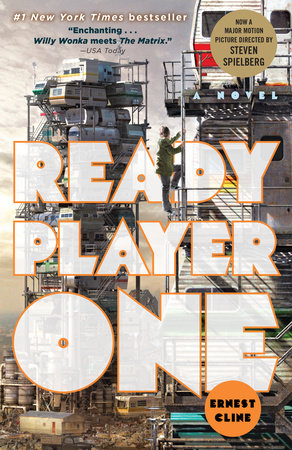TEACHING GUIDE
NOTE TO TEACHERSTeachers: If you’d like a printable version of this guide, click on the PDF link at the bottom of this page.
This is a novel set in the not-to-distant future: the year 2044.
Ready Player One provides a fascinating glimpse into the potential of advanced virtual reality technology. In fact, the author, Ernest Cline, recently spoke with
Forbes magazine about current breakthroughs in technology and the directions they could take us. (The article can be found at: http://www.forbes.com/fdc/welcome_mjx.shtml.) The story of a young man’s quest to win an “Easter egg hunt” in virtual reality, this novel is fast-paced and fun to read. This is the only novel in the guide that features computer science—a field that is particularly appealing to today’s high school students.
Discussion Questions and Activities: 1. Describe the extent and impact of global climate change in the novel. What caused the global energy crisis? How has it impacted society? Do you think it is possible that we will see a global energy crisis of this magnitude by 2044? Support your answer with data.
2. On page 25, Wade Watts explains how he creates a mechanism for recharging his device using, “a rack of old car batteries and a modified exercise bike.” Based on principles of physics, explain how this mechanism could work.
3. Watts describes preparing to play OASIS on page 26 and gives further details about the system on page 58. Explain how the technology involved in the components of the system work (for example, haptic technology, retina scans). How much of this technology currently exists?
4. OASIS stands for “Ontologically Anthropocentric Sensory Immersive Simulation.” Examine the etymology of each of the words in the system’s name. What do they tell you about the functions of the system? Examine names from other fields of science. How are scientific names generated? What can the etymology of a scientific name tell you about an organism or object?
5. Explain the code that allows for the creation of avatars. What allows them to interact with each other?
6. Since OASIS is free to access, how is the virtual world in
Ready Player One monetized? Do you think this model makes sense? Explain your answer. Rebecca Skloot’s book
The Immortal Life of Henrietta Lacks raises questions about the ownership of biological materials. Can similar questions be raised about the ownership of virtual commodities? Debate these questions as a class.
7. In computer programming, what are “Easter eggs”? What is involved in programming an Easter egg into a game, application, program, or site?
8. Once Wade begins to advance in the online egg hunt, he acquires more advanced equipment to use in OASIS. Read the descriptions of the technology on pages 191–193. How much of this technology currently exists in some form? Explain how it works.
9. What would be difficult about creating a system as expansive and immersive as OASIS? Do you think such a system will ever be created? Would people be willing to exchange real experiences for virtual experiences? Explain your answer.
10. In addition to providing a source of recreation, OASIS also provides access to education. How could virtual reality or other similar technology revolutionize the classroom experience? What steps have we already taken to promote “virtual classrooms” or distance learning? Do you think this type of learning will eventually replace the traditional classroom?
Lab Connections: Computer Programming, Engineering Correlates to Common Core Standards: Science & Technical Subjects: Key Ideas & Details RST.11-12.1, 11-12.2; Craft & Structure RST.11-12.4, 11-12.6; Integration of Knowledge & Ideas RST.11-12.8, 11-12.9; Writing Text Types and Purposes WHST.11-12.1a-f, 11-12.2a-f; Production & Distribution of Writing WHST.11-12.4, 11-12.5, 11-12.5; Research to Build & Present Knowledge WHST.11-12.7, 11-12.8, 11-12.9; Range of Writing WHST 11-12.10 Anchor Standards: Reading Key Ideas & Details CCRA.R.1, CCRA.R.2; Integration of Knowledge & Ideas CCRA.R.9; Writing: Text Types & Purposes CCRA.W.1, W.2; Production & Distribution of Writing CCRA.W.4, W.5, W.6; Research to Build & Present Knowledge CCRA.W.7, W.8, W.9; Language: Vocabulary Acquisition & Use CCRA.L.4, L.6; Speaking & Listening Comprehension & Collaboration CCRA.SL.1; Presentation of Knowledge & Ideas CCRA.SL.4 Other Titles of Interest: Neuromancer by William Gibson
Heavy Weather by Bruce Sterling
The Diamond Age by Neal Stephenson
Otherland: City of Golden Shadow by Tad Williams
Film Connection:The Matrix (1999) directed by the Wachowski brothers
Tron (1982) directed by Steven Lisberger

